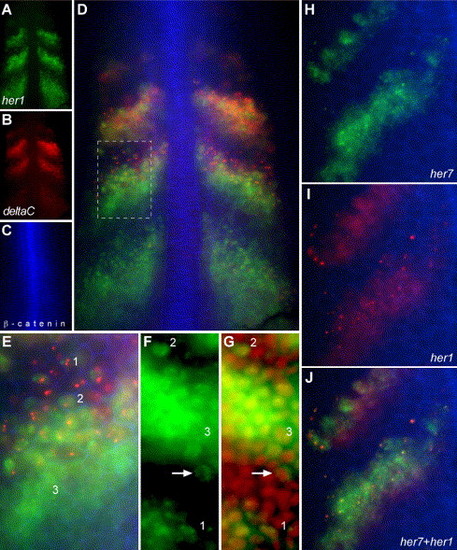Fig. 4
- ID
- ZDB-FIG-051114-3
- Publication
- Julich et al., 2005 - beamter/deltaC and the role of Notch ligands in the zebrafish somite segmentation, hindbrain neurogenesis and hypochord differentiation
- Other Figures
- All Figure Page
- Back to All Figure Page
|
Single-cell resolution of distinct phases of oscillations in transcription within the PSM. (A–E) A wild-type embryo stained for her1 mRNA (A), deltaC mRNA (B) and β-catenin protein (C). β-catenin protein in the cell cortex outlines each cell, allowing the examination of cell morphology and gene expression in the same cells. (D) Overlay of A, B and C. (E) Higher magnification view of the boxed region in D. In D, one can see that her1 and deltaC are differently regulated and that generally deltaC expression precedes (is shifted anteriorly relative to) her1 expression in the middle stripe, but not the other two stripes. However, in E, cells within the anterior of the middle stripe that express her1 but not yet deltaC can be seen. Note that her1 expression is more intense than deltaC expression in the posterior stripe and less intense than deltaC expression in the most anterior stripe, so that the “center of gravity” of the her1 distribution as a whole is posterior to that of the deltaC distribution. Also in E, three general patterns of mRNA localization can be seen. Pattern 1 appears as one or two intense spots while pattern 2 is broader but still restricted. In pattern 3, the mRNA is localized throughout the cell. Note that the intense spots of her1 and deltaC do not co-localize. (F, G) Patterns 1 and 2 are restricted to the nuclei. her1 mRNA localization (F) is compared to nuclei (red, propidium idodide staining) (G). The intense spots of pattern 1 co-localize to the nucleus suggesting that they may represent nascent transcripts at the her1 genomic loci. Pattern 2 co-localizes with the nucleus. The arrow shows a cell within the posterior of a stripe no longer is transcribing her1 and has exported most of the her1 mRNA into the cytoplasm. (H–J) Show the co-localization of the intense, subnuclear spots of her7 expression (H, green) and her1 expression (I, red). β-catenin localization is in blue in all panels. (J) Overlay of H and I. Since her1 and her7 are on the same chromosome, separated by only 12 kb, one would expect the intense, nuclear spots to co-localize if those spots represent nascent transcripts at the chromosomal loci. Likewise, the pattern 1 spots of deltaC and her1 would not be expected to co-localize since the two genes are on different chromosomes. (A–E, H–J) are wide-field images. (F, G) are confocal images. All panels are dorsal views of dissected tailbuds with anterior up. |
| Genes: | |
|---|---|
| Fish: | |
| Anatomical Terms: | |
| Stage: | 10-13 somites |
Reprinted from Developmental Biology, 286(2), Julich, D., Hwee, Lim C., Round, J., Nicolaije, C., Schroeder, J., Davies, A., Geisler, R., Lewis, J., Jiang, Y.J., Holley, S.A., Tübingen 2000 Screen Consortium., beamter/deltaC and the role of Notch ligands in the zebrafish somite segmentation, hindbrain neurogenesis and hypochord differentiation, 391-404, Copyright (2005) with permission from Elsevier. Full text @ Dev. Biol.

